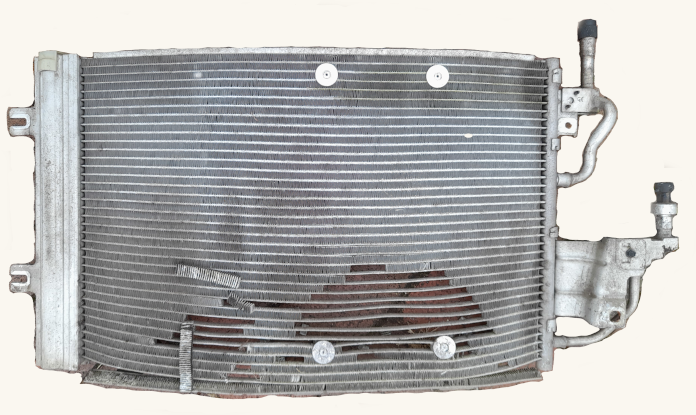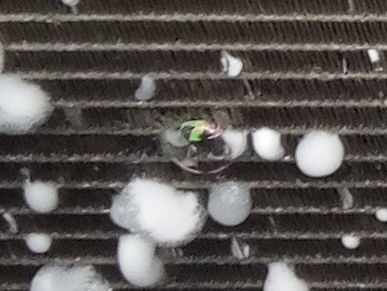Vehicle Air Conditioning Condenser Supply
Index > Air Conditioning > Condenser
Supply of vehicle air conditioning condensers at competitive pricing for many makes and models of car & van
Mobile service for refrigerant recovery, air conditioning pressure testing and regas covering
Telephone 07703 558610
email: sales(at)autoelectrics.net
Vehicle Air Conditioning Condenser
Car Van Truck and Tractor Air Conditioning Condensers are often located near to the front of the vehicle just in front of the coolant radiator, being susceptible to impact damage and corrosion liable to cause refrigerant leaks.
The air conditioning compressor produces high temperature, high pressure (super heated) refrigerant gas which is piped to the aircon condenser through which refrigerant state changes from a high pressure compressed gas to a liquid refrigerant.
The condenser gets warm during air conditioning operation.
This superheat is removed by a heat exchange process where hot
refrigerant transfers heat to the aluminium tubes and fins of the condenser.
Direction of refrigerant flow through the air conditioning condenser is from top inlet entering as superheated compressed vapour to bottom outlet leaving as a high temperature subcooled liquid refrigerant.
Heat exchange takes place as Cooling air is blown across the condenser heat exchanger (radiator) fins by vehicle radiator fans or condenser fan.
Condenser fan electrical operation may be controlled by a relay wired to temperature controller thermostats, switches, or climate control module.
Maintaining cooling efficiency - Keep the Air conditioner Condenser Clean !
On many vehicles the air conditioning condenser is located near to the front of the vehicle just in front of the coolant radiator. Build up of dust and debris across condenser fins causes air flow restrictions lowering air conditioning system efficiency.
Vehicle Air Conditioning Condenser Leaks
A damaged or deteriorated vehicle air conditioning condenser may be the source of refrigerant leaks.
Vehicle air conditioning condensers are often mounted in front of the radiator and intercooler components so prone to physical impact damage,
leaking seals and corrosion.
for example : stonechip impact, chaffing, accident crash damage.
The image below shows a heavily corroded aluminium condenser removed from a 2011 vauxhall astra in 2024. The customer reported his vehicle air conditioning system
had failed so had took to a fastfit garage for regas a couple of months earlier.
The new customer reported that the air conditioning had only worked for around three weeks after the fastfit regas and understood the air conditioning fault to be
auto electrical.
When our engineer inspected the vehicle, no refrigerant pressure showed on the
ac manifold gauges and the condenser condition was advised to the customer. Vehicle air conditioning systems are fitted with pressure switches. When refrigerant is lost, the ac low
pressure switch will trigger to prevent compressor clutch engagement and protect the system. A new condenser was ordered via us and fitted,
When new components are fitted, a Nitrogen pressure test is undertaken to check for air conditioning system tightness.

Both refrigerant and refrigerant lubricant may be lost due to vehicle air conditioning condenser leakage leading to operational failure of the vehicle air conditioning system.
Vehicle Air Conditioning Condenser Leak Detection
Visual inspection checks for physical damage to the air conditioner condenser may indicate areas where a leak is suspect. Presence of damp oily residue may appear where refrigerant oil has escaped.

Oxygen-Free Nitrogen (OFN) Pressure Testing
All remaining air conditioning refrigerant must be recovered by qualified persons before an OFN leak check of the AC system can take place.
Oxygen Free Nitrogen (OFN) gas is used to pressurise the air conditioning systems to locate leaks which could cause escape of refrigerant during system operation.
Ultraviolet (UV) Dye
The use of UV dye requires that the air conditioning system contains refrigerant and is operational.
UV tracer dye is injected in to the vehicle air conditioning system via the high or low pressure service ports possibly with system lubricant during regas.
Should a refrigerant leak occur, the area where refrigerant is escaping may sometimes be detected by a yellow glow under ultraviolet (blue) light.
UV leak detection works well if components are readily accessible and can leave identification traces where components are difficult to access.
Refrigerant electronic leak detection
A refrigerant electronic leak detector may aid finding refrigerant leaks from aircon condensers. Effective refrigerant leak detection using a 'sniffer' may requires that the air conditioning system is pressurised or operational.
Air Conditioner Low Pressure Fault Codes
Vehicles which have suffered refrigerant loss due to condenser failure may log fault codes as a result of low pressure switch activation or temperature detection.
in climate control electronic modules relating to refrigerant loss or low refrigerant pressure detected from pressure switch signals.
P0530 Air conditioner refrigerant circuit pressure malfunction
P0531 Air conditioner refrigerant circuit pressure range or performance
P0532 Air conditioner refrigerant pressure sensor input low
P0534 Low refrigerant circuit pressure
Air Conditioning Condenser Replacement
Replacement of a leaky vehicle air conditioning condenser can be a complex job depending on vehicle specification requiring use of specialist tools.
Firstly, any remaining air conditioning refrigerant will require safe recovery.
Refrigerant recovery
To comply with environmental rules, refrigerant recovery by F-Gas certified personnel is a legal obligation if the vehicle air conditioning system contains R134a refrigerantComponent disassembly and reassembly
Vehicle bodywork and trim components may need removal to gain access to the air conditioning condenser.
Replacement of the aircon condenser on certain vehicles may require bumper and front panel removal and refitment.
We recommend renewal of the air conditioning receiver dryer (if applicable) when a new condenser is fitted.
Pressure tests
After fitting a new aircon condenser the air conditioning system will require Nitrogen pressure test to ascertain no leaks are present.
The air conditioning system must be 'evacuated' using a vacuum pump, this also helps boil off any moisture in the system.
A vacuum hold test may be used as a further leak check.
Regas
The vehicle air conditioning system can be regassed after leak tests are passed and the system is free of leakage.
Air conditioning operational check
Operational checks are completed to check refrigerant pressures, temperatures, and general system operation.
Air conditioning climate control system fault codes may need to be cleared before air conditioner operation is restored.
further leak check
A final check for refrigerant leaks should be carried out after condenser renewal and action as appropriate.
Air conditioning HVAC repairs to : Vans * Trucks * Minibuses * Coaches * Ambulance * Construction equipment * Quarry plant * Agricultural machinery * Marine * Motorhome
Safety Risk Assessment must be undertaken and followed
Vehicle Air Conditioning Mobile Service in Local Areas:
Shrewsbury - Oswestry - Telford - Wem - Whitchurch - Much Wenlock - Ludlow - Welshpool - Ellesmere - Newtown
Air Conditioning Condenser Supply to
Motor Traders and Garages
Private Customers
Commercial Vehicle Air Conditioning
Road Haulage Fleets
Passenger Transport Taxi Bus Aircon
Agricultural Machine Air Coditioning
Construction Plant Aircon
Forestry Machinery AirCon
